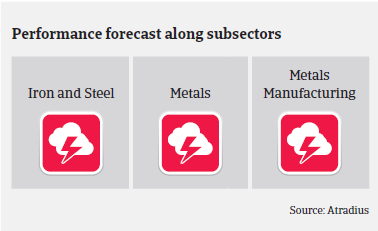The number of protracted payments and insolvencies was high in 2019, and is expected to increase further in 2020, mainly affecting private-owned producers.


Supply side reforms in China’s metals and steel industry improved overcapacity issues somewhat in 2017 and 2018. However, according to the National Bureau of Statistics, crude steel production increased again in the first eight months of 2019, up 9.1% year-on-year, to 665 million metric tons. This has coincided with high iron ore prices and a relaxation of production curtailments formerly introduced to increase environmental protection.
However, at the same time demand from key buyer sectors has decreased, mainly due to China´s ongoing economic deleveraging program, while the Sino-US trade dispute has negatively impacted domestic business sentiment. Metals and steel demand from the construction industry has weakened, as infrastructure investment has slowed down since 2018. Property investment is impacted by tighter government policies in order to reduce speculation in the supply heavy market. Growth of steel demand from the property sector is expected to slow to 2.9% in 2019, 1.1% in 2020, and to contract afterwards. Additionally, the slowdown in domestic automotive production and sales is having a negative impact on metals and steel suppliers.
Chinese steel businesses are also impacted by rising iron ore prices, while sales prices remain volatile. Replenishment of inventories after the Chinese New Year in February 2019 pushed steel prices up to USD 525 per tonne, but prices started to decrease again in Q2 of 2019 amid faltering domestic demand and are expected to hit new lows in H2 of 2019. As a result, Chinese steel manufacturers reported sharp declines in profit in 2019, and margins are expected to deteriorate further in the coming 12 months.
Payment in the Chinese steel and metals industry take between 60 and 120 days on average. The number and amount of protracted payments and insolvencies over the past 12 months was high, and is expected to increase further in 2020. While leading state-owned steel makers still show some resilience, many private-owned steel and metals producers face serious trouble. The majority of private Chinese metals and steel traders do not have sufficient fixed assets, and suffer from slim margins and very limited bank facilities.
Given the poor credit risk situation in the industry, our underwriting stance remains very restrictive, with cover strictly limited to businesses with strong financial profiles or state-owned background. Downstream businesses like manufacturers of oil pipes and metals/steel products with high-tech applications are also more resilient.
Related documents

1.06MB PDF
